The Great Game
Greg Martin
Liberty Wildlife Contributor
The reputation of the Arizona Bark Scorpion precedes it: only a few dozen of the 2,000 or so scorpion species in the world are potent enough, venomously speaking, to be considered dangerous, and it stands as North America’s deadliest.[1] Yet there’s so much more to them than a vicious sting. Researchers marvel at what these hardy little warriors can do: some scorpions can go a solid year between meals, while others have survived oxygen deprivation, accidental “drowning,” and even being frozen, ultimately springing back to life with little to no harm done.[2] Yet they’re not cold-blooded killers, at least when it comes to humans. Quite the opposite. Almost all incidents of scorpions stinging people come about accidentally; scorpions possess extremely poor vision and typically attack only when dangers (hands or feet) intrude upon them.[3] They deserve respect and caution, but not hatred or fear. For most small animals and especially insects, however, they rightly instill trepidation, if not outright terror.
Several years ago, a scorpion found itself exposed to the world in daylight, a rude awakening for an otherwise nocturnal being. Its tribulations quickly came to the attention of a nearby Cactus Wren. Said scorpion took off for shelter, raising its tail as a ward against danger. The wren flew down to challenge its passage.
Two combatants, scorpion and bird, faced off. The stage was set for a dramatic battle between avian and arachnid—
Until the wren calmly grabbed it by the tail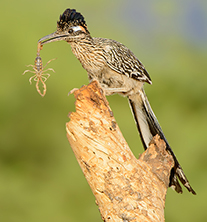 and beat it to death against a rock.
and beat it to death against a rock.
Having vanquished its foe, the killer flew away, never bothering to eat its victim, strangely content after bludgeoning it into nothingness.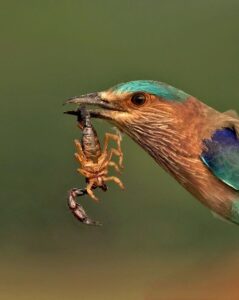
In the end, predators have two enemies (excluding humans): starvation, and each other. We often think of survival as epitomized in that fateful moment between hunter and prey, but the reality is that carnivorous animals must compete with, chase away, or even kill one another simply to stay alive themselves. Sometimes this is a matter of absolute danger; in other cases, as with the scorpion and the wren, it’s opportunism at its purest. When the chance to eliminate a potential threat or competitor arises, few animals will turn it down. That’s why owls kill roosting hawks whenever possible, striking while the latter are helpless because of their miserable night vision. Hawks eagerly return the favor during the day. They’re rivals competing over the same finite hunting grounds, and they approach their coexistence with a blood feud worthy of the Hatfields and Mccoys.
Sometimes, it’s a matter of respecting the hierarchy. An osprey would rather surrender a fish to a Bald Eagle than get into a fight it can’t possibly win; from the eagle’s perspective, it’s more convenient to engage in a little high seas piracy than go fishing and risk failure. There’s no real incentive to kill the osprey. Lions and hyenas, by contrast, waste no opportunity to attack one another if they can get a clear advantage; they fight for the position of apex predator, while simultaneously living in a world where the crocodile is king (but only in its watery realm). All the while, smaller predators forever wait in the wings to take whatever they can without getting caught in the crossfire. It’s an endless, brutal battle, with no final winner, and everything always at stake.
In some ways, it’s a game of chess, with each participant measuring the strengths and weaknesses of the other while carefully maneuvering to ensure their own survival. More often, however, stratagems take the simple route: just as paper covers mighty rock, the wren’s superior reach lets it easily thrash a scorpion without really endangering itself. What makes for a frightening predator in one circumstance might be easily negated in another. 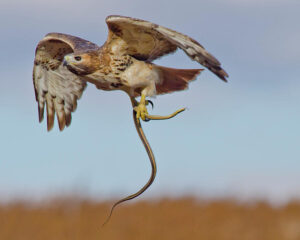 Terrestrial dwellers fear rattlesnakes with good cause, but Red-tailed Hawks happily seek them out as a food source. Larger animals shy away, but the raptor, extending its wings like some kind of tottering matador, goads the snake into striking harmlessly at feathers and thus overextending itself. The rattlesnake remains a fearsome creature, the bane of small animals and a source of discomfort for even the mightiest of mammals. Hawks simply possess the right degree of nimbleness to negate what would otherwise be a prohibitively lethal snakebite.
Terrestrial dwellers fear rattlesnakes with good cause, but Red-tailed Hawks happily seek them out as a food source. Larger animals shy away, but the raptor, extending its wings like some kind of tottering matador, goads the snake into striking harmlessly at feathers and thus overextending itself. The rattlesnake remains a fearsome creature, the bane of small animals and a source of discomfort for even the mightiest of mammals. Hawks simply possess the right degree of nimbleness to negate what would otherwise be a prohibitively lethal snakebite.
Tools, talent, sheer luck: survival is one of the few things universally greater than its composite parts. It doesn’t obey any rules, and it certainly comes with no guarantees. But for every competitor in this lethal game, from the wren to the raptor, winning at any cost definitely beats the alternative.
[1]https://www.nationalgeographic.com/animals/invertebrates/group/scorpions/
[2]https://askabiologist.asu.edu/explore/not-so-scary-scorpions
[3]https://animals.sandiegozoo.org/animals/scorpion
Wildlife Watching in the Burbs’
Gail Cochrane
Liberty Wildlife Volunteer
My backyard on the South Mountain preserve is a great place to see wildlife, and I’ve been pondering the changes in the critter population over the years. In the early days, we saw a lot of reptiles. The Arizona Herpetological folks took rattlesnakes out of our back yard with alarming regularity. Finally, one volunteer pointed out that our messy birdfeeder was the problem. The seeds on the ground were attracting rodents which were a beacon to snakes such as speckled, western diamondback and tiger rattlesnakes. We also encountered gopher snakes and a beautiful king snake that came right onto the back porch one evening. Snakes are rare these days.
We enjoyed seasonal visitations by chuckwallas. Big Chuck showed up every summer to graze in the grape vine that grew profusely on the block wall. 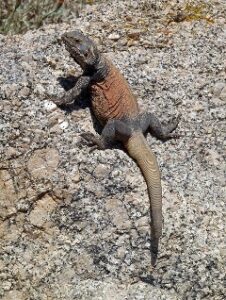 Chuck defended his territory from a younger chuckwalla in a memorable wildlife event, chasing the challenger off the wall and out of the yard. The grapevine died out some years ago and Big Chuck doesn’t come around anymore.
Chuck defended his territory from a younger chuckwalla in a memorable wildlife event, chasing the challenger off the wall and out of the yard. The grapevine died out some years ago and Big Chuck doesn’t come around anymore.
One morning a Sonoran Desert toad swam back and forth across the pool, faster than Michael Phelps. I scooped it out with the pool net and set it gently on the ground. It soon disappeared. I keep shallow dishes filled with water near the pool now in hopes the wildlife will use those instead of risking a pool disaster.
 We’ve been fascinated by a wide variety of lizards; whiptails, ornate tree lizards, spiny desert lizards, western banded geckos and desert iguana. The number of lizards is way down, and I suspect this is the result of the use of pesticides by neighboring homeowners. These are poisons of course, and they wipe out populations of insects that feed amphibians, reptiles and birds. Herbicides as well, those handy weed killers, are toxins that interfere with or outright poison wildlife.
We’ve been fascinated by a wide variety of lizards; whiptails, ornate tree lizards, spiny desert lizards, western banded geckos and desert iguana. The number of lizards is way down, and I suspect this is the result of the use of pesticides by neighboring homeowners. These are poisons of course, and they wipe out populations of insects that feed amphibians, reptiles and birds. Herbicides as well, those handy weed killers, are toxins that interfere with or outright poison wildlife.
Coyotes trot by outside our fence frequently, heading with purpose on hunting missions or just doing coyote stuff. We see javelina and the rare fox. A ringtail family had a home in the rocks out back one year and we could hear them snarling and quarreling in the evenings when we sat out by the chiminea.
Cactus wrens pecked insects from the undersides of the patio furniture in the early years. A brazen wren came in an open door one fine morning and perched calmly on the sofa. I don’t see them around anymore, but we sadly lost a couple of backyard trees that may have encouraged their presence here. Occasionally now, roadrunners canvas the block walls, searching for lizards.
Observing the ebb and flow of various populations it becomes ever more apparent how closely interwoven are the lives of wild birds and mammals with the insects and plants in their range. Human actions will always impact conditions for wildlife. Keeping this in mind as we go about our lives is the least we can do.
Pretty But Poisonous
Claudia Kirscher
Liberty Wildlife Volunteer
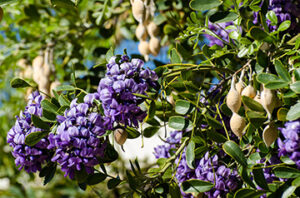
Here in the southwest desert, drought-tolerant native plants are a welcome addition to our home landscaping. A word of caution though, beautiful as the flowers and foliage may be, many are poisonous to both people and animals. Some, such as oleander, are well known for their toxicity while others are less well known.
The entire plant of the Mescal Bean Bush pictured above is poisonous. The woody pods contain red seeds. It is also known as “Texas Mountain Laurel.” If the seeds are chewed, they may cause nausea, vomiting, hallucinations, a fast heart rate, muscle weakness, and seizures.
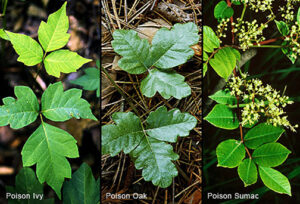 Poison ivy, poison oak and poison sumac are found in Arizona, sumac is less common. Poison oak and ivy can look similar. Just remember “leaves of 3 let them be.” Both plants have three leaflets, white flowers in spring, and can grow as a vine or a shrub. Depending on the season, leaf color can range from green to orange and even a dark purplish-red. Avoid burning these plants as smoke inhalation from these plants is toxic. The oil on the leaves causes an allergic skin reaction with severe itching and possibly blisters. Remember, if the oil is on your skin or clothing it can be spread to others.
Poison ivy, poison oak and poison sumac are found in Arizona, sumac is less common. Poison oak and ivy can look similar. Just remember “leaves of 3 let them be.” Both plants have three leaflets, white flowers in spring, and can grow as a vine or a shrub. Depending on the season, leaf color can range from green to orange and even a dark purplish-red. Avoid burning these plants as smoke inhalation from these plants is toxic. The oil on the leaves causes an allergic skin reaction with severe itching and possibly blisters. Remember, if the oil is on your skin or clothing it can be spread to others.
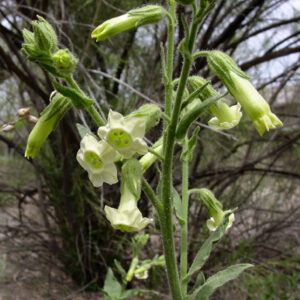 Desert Tobaccoflowers are tubular, the stems and leaves are green, hairy, and sticky. All parts of the plants are highly poisonous and contain alkaloids.
Desert Tobaccoflowers are tubular, the stems and leaves are green, hairy, and sticky. All parts of the plants are highly poisonous and contain alkaloids.
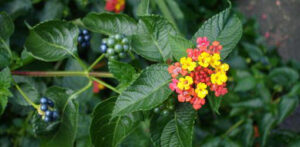 The Lantana green berries are poisonous and contain an atropine-like compound. Sheep, cattle, horses, and humans have been poisoned by Lantana.
The Lantana green berries are poisonous and contain an atropine-like compound. Sheep, cattle, horses, and humans have been poisoned by Lantana.
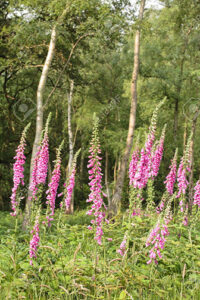 The Foxglove contains digitalis. The entire plant is poisonous.
The Foxglove contains digitalis. The entire plant is poisonous.
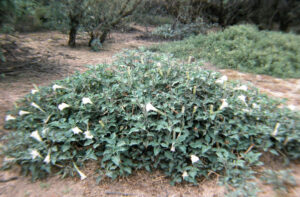
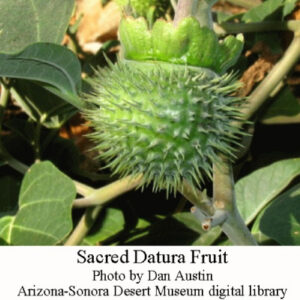 Jimson Weed is also known as Sacred Datura, Devil’s Trumpet and Sacred Thorn Apple. It has large white or purple-shaped flowers and spiky seed pods. Ingesting even small amounts of the plant or seeds can result in confusion, frightening hallucinations, the inability to urinate or sweat, overheating, and a rapid heart rate which can last hours or many days and can lead to death.
Jimson Weed is also known as Sacred Datura, Devil’s Trumpet and Sacred Thorn Apple. It has large white or purple-shaped flowers and spiky seed pods. Ingesting even small amounts of the plant or seeds can result in confusion, frightening hallucinations, the inability to urinate or sweat, overheating, and a rapid heart rate which can last hours or many days and can lead to death.
Hawk moths pollinate the flowers and lay eggs on the foliage. The caterpillars (called “hornworms” in this family) incorporate the plant’s toxins into their own tissues and become toxic to their potential predators.
 The New Mexico locust tree grows throughout Arizona in sunny canyons, mountain riparian areas, and coniferous forests. Lovely pinkish flowers bloom on the tree in late spring and early summer. When the flowers dry up a brown, hairy bean pod takes over. Just one bite of the seeds contained within those pods can kill a child or animal.
The New Mexico locust tree grows throughout Arizona in sunny canyons, mountain riparian areas, and coniferous forests. Lovely pinkish flowers bloom on the tree in late spring and early summer. When the flowers dry up a brown, hairy bean pod takes over. Just one bite of the seeds contained within those pods can kill a child or animal.
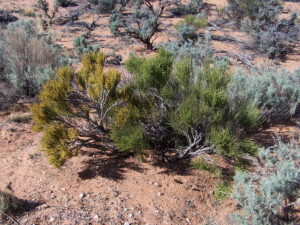 Mormon tea was used by the early pioneers and seemed to be safe when consumed as a beverage in normal food amounts, but there is not enough information. The plant does contain ephedrine and possible side effects include stomach complaints, kidney and liver damage, nose or throat cancer, increased urination, and constipation.
Mormon tea was used by the early pioneers and seemed to be safe when consumed as a beverage in normal food amounts, but there is not enough information. The plant does contain ephedrine and possible side effects include stomach complaints, kidney and liver damage, nose or throat cancer, increased urination, and constipation.
 Peyote: This small cactus contains the toxin mescaline. Ingestion of peyote causes nausea, vomiting, hallucinations, increased blood pressure, and a fast heart rate.
Peyote: This small cactus contains the toxin mescaline. Ingestion of peyote causes nausea, vomiting, hallucinations, increased blood pressure, and a fast heart rate.
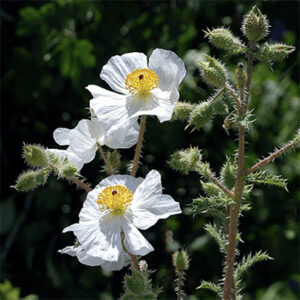 Prickly Poppy: The stems are brittle and covered in spines. The foliage will ooze yellow sap if broken. All parts of the plant are poisonous.
Prickly Poppy: The stems are brittle and covered in spines. The foliage will ooze yellow sap if broken. All parts of the plant are poisonous.
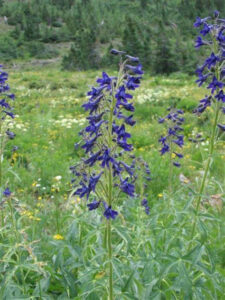 Larkspur ingestion by both humans and livestock leads to as neuro-muscular paralysis, leading to respiratory failure, bloat and often death. All parts of the plant are poisonous, but new growth and the seeds contain the highest concentrations of toxic substances. There is no proven treatment for larkspur poisoning.
Larkspur ingestion by both humans and livestock leads to as neuro-muscular paralysis, leading to respiratory failure, bloat and often death. All parts of the plant are poisonous, but new growth and the seeds contain the highest concentrations of toxic substances. There is no proven treatment for larkspur poisoning.
A little research and careful planting can keep you, your family and your pets safe while enjoying the color these plants can add to your yard.
Resources: Azpoison.com; desertmuseum.org ; raisingarizonakids.com; Arizona.edu ; acmt.net
Kid Stuff
Carol Suits
Nurturing Nature
Sometimes the best stories are ones we get to listen to. Here’s one about hummingbirds that was recorded a few years ago by Beth Surdut. She learned about hummingbirds by paying attention to those that visited her backyard. Find out what happened when a hummingbird flew into her house or when another hit a window and got knocked out!
https://radio.azpm.org/s/37262-the-art-of-paying-attention-hummingbird-etiquette/
Liberty Wildlife has six stories, called Sky Stories that you will like. Each one is about a different species of bird and two are about mammals that are active at night, called nocturnal. Episode 3 is all about hummingbirds. https://anchor.fm/sky-stories
Hummingbirds are amazing! Here are some ways they are different from other birds.
https://www.birdnote.org/show/hummingbirds-are-mighty-puffballs
This video shows how easy it is to draw a hummingbird.
https://www.youtube.com/watch?v=SA6Dt7ndmyM&list=UUuLXeJAKL-FL-wJBNqLbubQ


